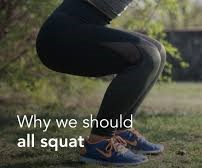
Why We Must Squat

Hello, my friends,
In my previous blog, I asked your Why or Turning Point. I also shared some success stories of real clients who found their whys and turned their lives around for the better. Well, this week, I met with a lady for a consultation at the studio, and when I asked her: “-Why now?” she said she was having difficulty getting up from her low Italian sofa.
Unfortunately, she is like countless others who struggle with everyday tasks, such as getting up from a sofa or stepping in and out of a car (that is not an SUV), due to declining lower body strength.
Everyone knows that exercise has a protective effect on health and is critical for long life. However, you might not know that two of the strongest predictors of longevity are strength and muscle mass in the lower body.
A study of over 2,000 participants, ages 51 to 80, found that those who were better at getting up from the floor without assistance (using their hands or knees for support) were less likely to die over the next six years. Conversely, those with the weakest legs had the highest mortality risk.
What can we do to slow or even reverse this trend?
One of the easiest and most effective approaches may be to stand up more often and then get back down. That means: We need to squat more!
When it comes to building muscles in our lower body, the squat is the king!
Squats are suitable for all ages because there are infinite ways to modify, progress, regress, and adjust to accommodate the abilities and limitations of the individual. When done correctly, the squat is beneficial regardless of the difficulty level. In addition, it is a functional exercise representing a movement we need to do every day: going from sitting to standing and vice-versa.
Losing our ability to stand up from a chair alone or get in and out of a car will cause us to lose independence. It could be the difference between aging in place and aging in a nursing home.
Squats hit all the major muscles in our lower body, such as thighs (quads and hams), calves, and hips (glutes and hip flexors). Keeping these muscles strong will give you a great-looking tush (because no one wants a sagging one). It also helps us walk, run, climb stairs and stand up from a chair comfortably.
Squats also improve strength and stability in the core muscles and mobility in the hips and ankles, making movements like turning, bending, and carrying much more effortless.
Without sufficient usage, Sarcopenia takes over, which causes our muscles to atrophy or weaken over time. Maintaining strength and power in our lower body is crucial to keeping our balance and preventing falls, the leading cause of fatal and non-fatal injuries in those over 65.
Here are some other benefits of the squat:
1. Reduces Risk of Injuries: When we strengthen our lower body muscles, we can better execute full-body movements with correct form, balance, mobility, and posture. Plus, incorporating squats in our workout routine also helps strengthen our tendons, ligaments, and bones, which may help reduce our risk of injury.
2. Crushes Calories: When we think about calorie burning, we often equate it with aerobic exercises such as running or cycling. But performing high-intensity, compound movements like the squat can also crush some serious calories.
3. Boosts Athletic Ability: If you play any sport, adding squats to your workout will help you develop explosive strength and speed, which, in turn, will help improve athletic performance.
4. Can Be Done Anywhere: We do not need equipment to do squats. All we need is our body and enough room to lower our tush into a sitting position.
Doing squats benefit all other major muscle groups. Start by doing 50 squats daily: 25 in the morning and 25 at night. Then, as you get stronger, add 25 to the afternoon too.
Talk to us about your ability to get up and down from your sofa. We can teach you the correct way to do the most important exercise you need to do to Stay Strong and Live Long!
See you soon.




